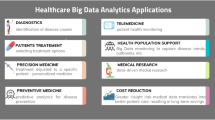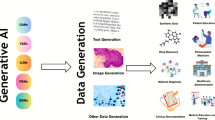Abstract
As medical services increasingly trying to harness advances in connected medical devices and the use of artificial intelligence, a new modeling strategy is essentially required to enable developers of the emerging medical applications to organize, integrate, and retain information in this new era of service-oriented healthcare. Such strategy needs to adhere to the principle of knowledge coupling that was advocated by Lawrence Weed, the father of modern problem-oriented medical records, in early 1970s where he defined the way medical information should be described for higher decision making. There has never been a more compelling time to use knowledge coupling related to both medical knowledge and the services build around them. The new digital technologies such as microservices, graph-based databases, Internet of Healthcare Things, and Cloud Computing as well as the non-digital disruptive events such as the pandemic have accelerated the adoption of new notions of service integration and knowledge coupling to provide the long waited solution for interoperability in healthcare as well as higher level of knowledge integration and analytics. The cornerstone of every new change is pointing toward the use of microservices and knowledge graph APIs to be able to thrive and lead in the uncertainty and healthcare change. This research paper uses the notion of mindmap to push conversation and guide scholars in developing effective microservice-based care systems that utilize knowledge graphs and the new care standards including the HL7 FHIR. Central to our mindmap is the GraphQL graph-based technology and the medical diagnosis as a service. This mindmap is the starting research point of our MITACS 2021 and NSERC DDG 2021 projects.






Similar content being viewed by others
Notes
References
Aceto G, Persico V, Pescapé A (2020) Industry 4.0 and health: internet of things, big data, and cloud computing for healthcare 4.0. J Ind Inf Integr 18:100129
Cassettari L, Patrone C, Saccaro S (2019) Industry 4.0 and its applications in the healthcare sector: a systematic review, XXIV Summer School “Francesco Turco”—Industrial Systems Engineering. http://www.summerschool-aidi.it/edition-2019/cms/extra/papers/441.pdf
Albert SM, Shevchik GJ, Paone S, Martich GD (2011) Internet-based medical visit and diagnosis for common medical problems: experience of first user cohort. Telemed e-Health 17(4):304–308
Mun SK, Wong KH, Lo S-C, Li Y, Bayarsaikhan S (2021) Artificial intelligence for the future radiology diagnostic service. Front Mol Biosci 7:512
Doi K (2007) Computer-aided diagnosis in medical imaging: historical review, current status and future potential. Comput Med Imaging Graph 31(4–5):198–211. https://doi.org/10.1016/j.compmedimag.2007.02.002
Cillessen FHJM, de Robbe VPF (2012) Modeling problem-oriented clinical notes. Methods Inf Med 51(06):507–515
Berner ES, Graber ML (2008) Overconfidence as a cause of diagnostic error in medicine. Am J Med 121(5):S2–S23
Heredia JS, Flores-García E, Solano AR (2019) Comparative analysis between standards oriented to web services: SOAP, REST and GRAPHQL. In: International conference on applied technologies, pp. 286–300. Springer, Cham
Kozhevnikov VA, Shergalis DV (2021) MIGRATING FROM REST TO GRAPHQL. Theor Appl Sci 1:180–185
Mukhiya SK, Rabbi F, Pun VKI, Rutle A, Lamo Y (2019) A GraphQL approach to healthcare information exchange with HL7 FHIR. Procedia Comput Sci 160:338–345
Biehl M (2018) GraphQL API Design. Vol. 5. API-University Press, ISBN-10: 1979717524
Brito G, Valente MT (2020) REST versus GraphQL: a controlled experiment. In: 2020 IEEE international conference on software architecture (ICSA), pp. 81–91. IEEE
Bettoni GN, Camargo T, Santos BGTD, Flores CD, Silva Da FS (2021) Application of HL7 FHIR in a microservice architecture for patient navigation on registration and appointments. Preprint http://arxiv.org/abs/2103.07589
Ahir Y, Rathkanthiwar SV, Kale Y (2019) A review on teleconsultation and telediagnosis using IoT module. In: 2019 International conference on communication and signal processing (ICCSP), pp. 0153–0156. IEEE
Dane A (2021) Beyond REST rapid development with GraphQL microservices, Netflix Technology Blog, Feb 22, 2021. https://netflixtechblog.com/beyond-rest-1b76f7c20ef6
Stünkel Patrick, Bargen von O, Rutle A, Lamo Y (2020) GraphQL federation: a model-based approach. J Object Technol, Article 18. http://www.jot.fm/issues/issue_2020_02/article18.pdf
Goyal P, Ferrara E (2018) Graph embedding techniques, applications, and performance: a survey. Knowl-Based Syst 151:78–94
Farouzi A, Bellatreche L, Ordonez C, Pandurangan G, Malki M (2020) PandaSQL: parallel randomized triangle enumeration with SQL queries. In: Proceedings of the 29th ACM international conference on information and knowledge management, pp. 3377–3380
Acknowledgements
This research is funded by the first author NSERC Discovery Grant 2021 (Discovery Development Grant DDG-2021-00014) and the MITACS research project of both authors (MITACS_IT22305).
Author information
Authors and Affiliations
Corresponding author
Ethics declarations
Conflict of interest
No form of conflict of interest is to be declared.
Additional information
Publisher's Note
Springer Nature remains neutral with regard to jurisdictional claims in published maps and institutional affiliations.
Rights and permissions
About this article
Cite this article
Mohammed, S., Fiaidhi, J. Establishment of a mindmap for medical e-Diagnosis as a service for graph-based learning and analytics. Neural Comput & Applic 35, 16089–16100 (2023). https://doi.org/10.1007/s00521-021-06200-6
Received:
Accepted:
Published:
Issue Date:
DOI: https://doi.org/10.1007/s00521-021-06200-6




